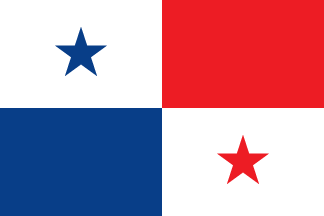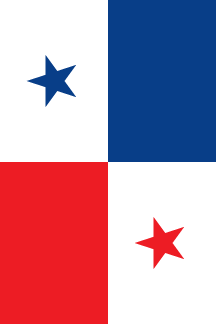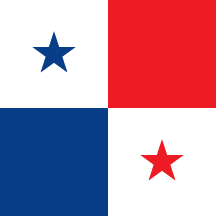
2:3
image by Brian Ellis, 20 July 2009

Last modified: 2010-01-22 by dov gutterman
Keywords: panama | america | star (blue) | star (red) | star: 2 | central america | colon |
Links: FOTW homepage |
search |
disclaimer and copyright |
write us |
mirrors

2:3
image by Brian Ellis, 20 July 2009
Flag adopted 20 December 1903
coat of arms adopted 4 June 1904 and legislated officially 15
December 1949.
Official Name: Republic of Panama (Republica
de Panama)
Capital: Panama
Location: Central America
Government Type: Constitutional Democracy
Flag adopted: 28
March 1941 (First hoisted 20 December 1903)
Coat of Arms adopted: 4 June 1904
ISO Code: PA
See also:
Other sites:
The current national flag was confirmed by Law 48 of 1925, and
ratified by law 28 of 28 March 1941. The blue and red is for the
Conservative Party and Liberal Party; the white is for peace; the
blue star is the purity and honesty of the life of the country;
the red star is for authority and law in the country.
Jaume Ollé, 4 September 1996
From <www.pa/patria/simbolos.html>,
located by Jarig Bakker:
Flag of Panama
The Panamanian flag was design by Mr. Amador Guerrero and made by
[his wife] Ms. Maria Ossa de Amador.
The Panamanian flag is a rectangle divided into four quarters:
the top hoist one, white with a five-pointed blue star; the top
fly one, red; the bottom hoist one, blue; and the bottom fly one,
white with a five-pointed red star
The combination of its three colours has this meaning: white
stands for the long-expected peace through the pacifical union of
the historical parties, the Liberal one represented by red and
the Conservative one by blue.
Baptism of the Flag
On December 20th 1903 the emblem was baptised, acting as
Godparents [sic] Dr. Gerardo Ortega with Ms. Lastenia de Lewis
and Mr. José Agustín Arango with Ms. Manuela M. de Arosemena.
Rev. Fray Bernardino de la Concepción García gave his blessing.
Legal adoption of the Flag
The Constituent Assembly provisionally approved the flag by Law
64 of 1904. It was definitively approved through Law 4 of 1925
written by the National Assembly and ratified by Law of March
28th 1941.
Translated by Santiago Dotor , 13 December 1999
From Smith [smi75]:
"The orderly division of the field suggested alternation of
the parties at the helm of the government. blue and red were also
associated with the Atlantic and Pacific Oceans, which flank
Panama."
From DK Pocket Book [udk97]:
"Red was the colour of the Conservatives and blue that of
the Liberals." Error?
Ivan Sache , 26 December 1999
Crampton - The World of Flags (1990: '...it is said that its
colors stand for the Colorados (the "Reds", or radical
party) and for the Conservatives, the traditional parties of the
time, with white for peace. It was designbed by the first
President, Manuel Amador Guerrero, and first hoisted on 20
December 1903...'
The Encyclopedia (1999): 'The blue and red are the colors of the
main political parties (Conservatives and Liberals respectively)
and the white denotes peace between them. The blue also
symbolizes the Pacific Ocean and the Caribbean, and the red
stands for the blood of those who lost their lives for their
country. The blue star represents the civic virtues of purity and
honesty, and the red star is a symbol of authority and law.'
Jarig Bakker , 26 December 1999
A friend of mine told me that in the recent events of
retrocession of the Canal, Panama National Flags sere usually
seen in ration 1 : 2 can anyone confirm ?
Armand du Payrat, 28 December 1999
Smith is totally incorrect, DK Pocket Book is incomplete.
Crampton - The World of Flags (1990) got the red Liberal party
wrong and the designer was Manuel Amador Jr., not the President
Manuel Amador Guerrero. The Encyclopedia (1999) is accurate
and complete.
Alvaro Aguilar, 31 August 2001
According to [pay00] -
National flag (2:3) and (1:2). Measurement of stars from both
Album and Flaggenbuch gives for diameter of the stars 30% of the
flag hoist. Album, as well as Smith, has the FIAV grid totally
filled for this flag, thus meaning it is used on land as civil,
state and war flag and at sea as civil, state and naval ensign.
Smith gives the flag proportion as approximate 2:3. Album shows
the flag in proportion 2:3, but caption says 2:3 and 1:2.
Approximate colour specifications in Album are:
Red: Pantone 186c - C0:M90:Y8:K5
Blue: Pantone 300c - C100:M45:Y0:K0
Anything on other flags such as a Prsidential flag, for instance?
Ivan Sache, 23 june 2002
I would pssibly have chosen some darker shade of blue to draw
this. In any case, [smi82] show
the blue rather dark, and some other sources also choose darker
(if maybe not so dark one). Possibly there is a realtion with US
shades? Then maybe not.
Not that I am aware of any other flags. Nither Flaggenbcuh, not
Smith nor National Geographics mention any other flags. n fact
Crampton in [cra90f] clearly says
in the "Other flags" field "None."
Željko Heimer, 23 june 2002
Does this mean that Album gives construction details? As far
as I can see no two flag books picture this flag with the same
ratio for the stars. Most sources appear to agree that the shade
of blue should be the same as that used in the flag of Costa Rica.
There also appears to be some variety on the history of this flag
and the proposal before that, but do we know what the first
version of this flag looked like?
Siegel [sig12] describes both
stars as red, but the images does show the current flag.
Peter Hans van den Muijzenberg, 7 July 2002
The website <www.pa/patria/simbolos.html>
(located by Jarig Bakker) has the text of the 1949 decree on use
of the flag. Article 2 has the following to say about
proportions: "Article 2: The Flag of the Republic has the
following dimensions: three meters in length by two in
width for those flown on public buildings, warships and merchant
ships; one meter 80 centimeters in length by one meter 44
centimeters in width for the colors [pabellones] of units of
infantry and artillery; of one meter square [for t]he standards
of cavalry[.] [F]lags for official automobiles will measure
47 centimeters in length by 32 centimeteres in width."
My brackets are my emendation of a text that, on the website,
actually says "...infantería y artillería; de un metro
cuadrado. Los estandartes de caballería y las Banderas de los
automóviles de uso oficial medirán ...." This makes
sense to me only if the period after "quadrado" is
changed to a comma and a new sentence is begun after
"caballería." Otherwise the phrase "de un
metro quadrado" doesn't apply to any flag, and the poor
cavalrymen are left carrying an absurdly small standard.
The same site also has rules for vertical hoisting/rotate and
reverse so the blue star is in the flag's upper right and the red
one in the flag's lower left.
Joe McMillan, 20 September 2002
This gives ratios 2:3, 4:5, 1:1 and 32:47. The Album mentions
possibility 1:2. Is there any legal background for that?
Sadly enough, the regulations says nothing on the size of the
stars. Ivan estimates them to 30% of hoist, based on Flaggenbuch
and Album.
Željko Heimer, 23 September 2002
The Mariner's Handbook, edit 0999, British HO Taunton,
presents it as 1:2
Armand du Payrat, 23 September 2002
Note that the 4:5, 1:1, and 32:47 ratios are for very
specialized uses.
Joe McMillan, 23 September 2002
One may then say that the Panamian flag is simply 2:3, as we
do for the others too. However, the main point I wanted to ask
was regarding the 1:2 ratio, which seems is not legally
sanctioned, but apparently used. I wander if the use of that long
flag might be happening only as an ensign - Panamian ensign is
among the most popular flags of conviniance, and therefore there
certainly are many ships carrying ensigns that not only are
produced abroad Panama, but probably haven't seen Panamian coasts
ever. If 1:2 version is not frequent unofficial variant - we
might want to drop it alltogether.
Željko Heimer, 24 September 2002
According to [pay00] -
National Flag (CSW/CSW 2:3 and 1:2) - Size of stars is estimated
on FOTW to 3/10 of hoist.
Željko Heimer, 7 October 2002
On 22 November 2005, "Dia
a Dia" reported a flag of Panama deemed
"disrespectful". The flag, hoisted over a shop in the
town of Santiago, has the stars "with special effects",
that is four additional drops of the same colour near each star.
The "disrespectful" flag was reported by Aristides
Caballero, who considered it as "an offense against
a national symbol". He added that the flag had
been hoisted by "foreign shop owners".
Ivan Sache, 20 February 2008
It was told that the Panamanian flag stands for hoped-for
peace (white) between the Conservatives (blue) and Liberals
(red).
A paragraph in Wikipedia's
article on the history of the country may provide a clue - and if
so it was the two factions in the country at the time of
independence in 1821:
"Panama joined the independence bandwagon like most of the
other Central American countries, in 1821. While Panama was of
great historical importance to the Spanish Empire, the
differences in social and economic status between the more
liberal area of Azuero, and the much more royalist and
conservative area of Veraguas displayed contrasting perspectives.
It is, in fact, known that when the Grito de la Villa de Los
Santos ["a unilateral decision by the residents of Azuero
(without backing from Panama City) to declare their separation
from the Spanish Empire."] occurred, Veraguas firmly opposed
the motion for independence."
James Dignan, 22 April 2009
There is a "Protocol Manual for the Use of National
Symbols" (my translation of the Spanish title) that was put
out in 2006 by Comisión Nacional de Desfiles Patrios (National
Commission of Patriotic Parades), a division of the Ministry of
Education. This document stipulates that official proportions are
2:3 and gives star measurements as 0.5m on a 2m by 3m flag (p.17
in Manual). The only info I could not glean from the document is
if the stars are 0.5m from top point to bottom points or if it's
inscribed within a 0.5m circle (my illustrations use the circle).
Other formats are as follows (all outlined on p.17 in Manual): Infantry and Artillery version of the flag,
dimensions 180:144. Cavalry version,
dimensions 1:1. Car flag version, dimensions
32:47
Brian Ellis, 20 July 2009
It is known that the first flag was hurriedly thrown together
in secret, and many histories suggest that a mistake was made
with its construction in that the red (rather than the blue)
panel should have appeared in the upper hoist.
Christopher Southworth, 6 August 2009
Panama's Flag Day (Día de la Bandera) is on November 4th.
Source: <www.pa>.
Jim, 23 January 2006

official flag
image by Brian Ellis, 20 July 2009

reverse/flag in use
image by Brian Ellis, 20 July 2009
Photo at <www.epasa.com>
show vertical hoisting of the flag. The flag is rotated 90
degreed to the right while the stars are kept in their original
orientation, which means that it is a regular flag,
only rotated.
Dov Gutterman, 10 October 2005
Maritza post of 18 July 2009, point us that the the
flag is wrond based on Spanish
wikipedia.
However, there doesn't seem to be an official source quoted, so
in this instance. Wikipedia itself cannot be considered an
entirely "trustful reference".
We on the other hand, show an officially displayed flag which can
be so considered, however, we appear to have interpreted it
incorrectly
It appears to me that we have the illustration wrong, both from a
point of view of the information on Wiki and the source quoted by
ourselves. The vertically hoisted flag is indeed
simply rotated in the conventional manner, but I must remind you
that this would place the canton at the dexter not at the
sinister as we show it. The photo' is plainly of a flag's
reverse.
When hanging a flag vertically the conventional
rules are simple - when hung flat against some object etc., the
canton must always be towards the dexter, yet when hanging from a
horizontal pole at right angles to any building one surely places
the upper edge of that flag away from that building and up to the
truck. The Panamanian authorities are treated the lamp post
to which the horizontal poles are attached as if it were a
building, and this being so, the photo' is plainly of a flag's
reverse
However, that regulations do vary (albeit sometimes only
slightly) from country to country and that they (if they exist at
all) are often totally ignored.
Christopher Southworth, 19 July 2009
This article of the Spanish
wikipedia about the flag of Panama does address the question
in its current version, last edited in 2009.05.14. But it just
states that "En los balcones "(…)
("Vertical:") se coloca con el cantón de la estrella
azul al lado izquierdo superior del observador", which means
that on balconies (and, we may assume, in all other flag hanging,
not hoisting, situations), the blue star goes to the
viewer’s upper left - but this statement is not backed up by
a specific refference to a legal document, albeit a number of
them is listed under “Referencias”.
The image (and its copies and pervious versions) lacks likewise a
source to back up the conveyed information. In short, what’s
on the article of the spanish Wikipedia about the flag of Panama
is probably true but not backed up enough.
The report of 10 October 2005, reports and briefly describes and
comments a photo of actual flag in use with the blue star on the
upper fly on row of flags displayed from two parallel beams
attached at right angles to a vertical pole, holding the flag by
its design hoist and fly.
Is this a wrong practice, according to the relevant law? Maybe,
but it is a report of an actual use, seemingly authorized by a
municipal body. Even if not legal, it is reportworthy, and is not
claiming more than a plain sight report.
António Martins-Tuválkin, 20 July 2009
There is a "Protocol Manual for the Use of National
Symbols" (my translation of the Spanish title) that was put
out in 2006 by Comisión Nacional de Desfiles Patrios (National
Commission of Patriotic Parades), a division of the Ministry of
Education. This document stipulates on vertically hung flags, the
blue field should be to the observers right, not left.
Brian Ellis, 20 July 2009

image by Brian Ellis, 20 July 2009
Based on Protocol Manual for the Use of National Symbols"
(my translation of the Spanish title) that was put out in 2006 by
Comisión Nacional de Desfiles Patrios (National Commission of
Patriotic Parades), a division of the Ministry of Education.
Infantry and Artillery version of the flag, dimensions 180:144.
Brian Ellis, 20 July 2009

image by Brian Ellis, 20 July 2009
Based on Protocol Manual for the Use of National Symbols"
(my translation of the Spanish title) that was put out in 2006 by
Comisión Nacional de Desfiles Patrios (National Commission of
Patriotic Parades), a division of the Ministry of Education.
Cavalry version version of the flag, dimensions 1:1.
Brian Ellis, 20 July 2009

image by Brian Ellis, 20 July 2009
Based on Protocol Manual for the Use of National Symbols"
(my translation of the Spanish title) that was put out in 2006 by
Comisión Nacional de Desfiles Patrios (National Commission of
Patriotic Parades), a division of the Ministry of Education.
Car flag version version version of the flag, dimensions 32:47.
Brian Ellis, 20 July 2009


image by Fred Drews and Francisco Gregoric, 18
July 2007
Panama - Flag of convenience on several ships. The one which
amazed me the most was the ferry from Flensburg (Germany) to
Kollund (Denmark), that I was on myself. This ferry, that never
gets out of the fjord, is flying the flag of a land it couldn't
even reach. (Not only because it probably couldn't carry its own
fuel for an Atlantic journey, but it couldn't sail the high seas;
it was really just an inland sightseeing ship mis-used as
passenger (and bicycle) ferry. Since this ferry sailed under the
Panamanian flag, does that mean I've been to Panama? To what
extend were Panamanian laws valid, while we were crossing from
German territorial waters directly into Danish?
Peter Hans van den Muijzenberg, 28 August 2001
It is also that the Panamanian flag is also a convenience flag
used in the shipping industry. However I was surprised to hear of
a Danish ferry flying the Panamanian flag as I have no idea if
that is actually allowed by the governing laws. The term
"convenience" derives from the fact that IF a ship is
to do regular crossings of the Panama canal AND it is registered
under Panamanian flag, then it is elegible for discount on the
toll paid to make the transit on the Panama Canal. Other than
that there is no other benefit that I know. Do note that this
however also has a dark side attached to it. There have been
numerous cases of foreign ships flying (by convenience) the
Panamanian flag -and that are NOT Panamanian ships- which are
seized by authorities due to trafficking of drugs. Unfortunately
the news always tend to say "a ship with panamanian
flag...." omitting the fact that the ship (and most of the
times not even its crew or owner) are related to Panama except
for the flying of the flag in order to make cheaper transits.
Didimo Grimaldo, 30 January 2005